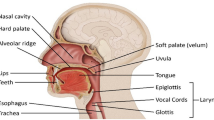Abstract
This paper suggests a new method to improve the performance of the pathological/normal voice classification. The effectiveness of the mel frequency-based filter bank energies using the fisher discriminant ratio (FDR) is analyzed. Also, mel frequency cepstrum coefficients (MFCCs) and the feature vectors through the linear discriminant analysis (LDA) transformation of the filter bank energies (FBE) are implemented. In addition, we emphasize the relation between the pathological voice detection and the feature vectors through the FBE-LDA transformation. This paper shows that the FBE LDA-based GMM is a sufficiently distinct method for the pathological/normal voice classification. The proposed method shows better performance than the MFCC-based GMM with noticeable improvement.
Access this chapter
Tax calculation will be finalised at checkout
Purchases are for personal use only
Preview
Unable to display preview. Download preview PDF.
Similar content being viewed by others
References
Michaelis, D., Forhlich, M., Strobe, H.W.: Selection and combination of acoustic features for the description of pathological voices. J. Acoust. Soc. Am. 103(3) (1998)
Qi, Y., Hillman, R.E., Milstein, C.: The estimation of signal-to-noise ratio in continuous speech for disordered voices. J. Acoust. Soc. Am. 105(4) (1999)
Vieira, M.N.: On the influence of laryngeal pathologies on acoustic and electroglottographic jitter measures. J. Acoust. Soc. Am. 111 (2002)
Hansen, J.H.L., Gavidia-Ceballos, L., Kaiser, J.F.: A nonlinear operator-based speech feature analysis method with application to vocal fold pathology assessment. IEEE Transactions on Biomedical Engineering 45(3), 300–313 (1998)
Childers, D.G., Sung-Bae, K.: Detection of laryngeal function using speech and electroglottographic data. IEEE Transactions on Biomedical Engineering 39(1), 19–25 (1992)
Oliveira Rosa, M., Pereira, J.C., Grellet, M.: Adaptive estimation of residual signal for voice pathology diagnosis. IEEE Transactions on Biomedical Engineering 47(5), 96–104 (2000)
Reynolds, D.A., Rose, R.C.: Robust Text-Independent Speaker Identification Using Gaussian Mixture Speaker Models. IEEE transaction on speech and audio processing 3, 72–83 (1995)
Molla, M.K.I., Hirose, K.: On the Effectiveness of MFCCs and their Statistical Distribution Properties in Speaker Identification. In: IEEE international conference on VECIMS, pp. 136–141 (2004)
Godino-Llorente, J.I., Aguilera-Navarro, S., Gomez-Vilda, P.: Dimensionality Reduction of a Pathological Voice Quality Assessment System Based on Gaussian Mixture Models and Short-term Cepstral Parameters. IEEE transaction on biomedical engineering, accepted for future publication
Olivier, S.: On the Robustness of Linear Discriminant Analysis as a Preprocessing Step for Noisy Speech Recognition. In: Proc. IEEE conference on acoustics, speech, and signal processing, vol. 1, pp. 125–128 (1995)
Kay Elemetrics Corp.: Disordered Voice Database. ver.1.03 (1994)
Kent, R.D., Ball, M.J.: Voice Quality Measurement. Singular Thomson Learning, San Diego (1999)
Author information
Authors and Affiliations
Editor information
Rights and permissions
Copyright information
© 2007 Springer Berlin Heidelberg
About this paper
Cite this paper
Lee, JY., Jeong, S., Hahn, M. (2007). Classification of Pathological and Normal Voice Based on Linear Discriminant Analysis. In: Beliczynski, B., Dzielinski, A., Iwanowski, M., Ribeiro, B. (eds) Adaptive and Natural Computing Algorithms. ICANNGA 2007. Lecture Notes in Computer Science, vol 4432. Springer, Berlin, Heidelberg. https://doi.org/10.1007/978-3-540-71629-7_43
Download citation
DOI: https://doi.org/10.1007/978-3-540-71629-7_43
Publisher Name: Springer, Berlin, Heidelberg
Print ISBN: 978-3-540-71590-0
Online ISBN: 978-3-540-71629-7
eBook Packages: Computer ScienceComputer Science (R0)





